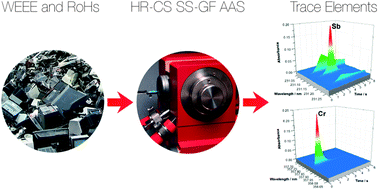Determination of chromium and antimony in polymers from electrical and electronic equipment using high-resolution continuum source graphite furnace atomic absorption spectrometry
Abstract
In the last few years, the European Union adopted two directives: the Waste Electrical and Electronic Equipment (WEEE) directive and the Restriction of Hazardous Substances (RoHS) directive. The RoHS directive had a major impact on the routine control of hazardous substances, including toxic trace metals in all kind of materials that are used in electrical and electronic equipment. This work proposes an analytical method for the determination of Cr and Sb in polymers from different electrical and electronic equipment using direct analysis of solid samples and high-resolution continuum source graphite furnace atomic absorption spectrometry with calibration against aqueous standards. Additional strategies are presented for reducing the sensitivity in order to cope with high analyte concentrations. The limit of detection was found to be 0.06 mg kg−1 for both analytes, Cr and Sb, and the characteristic mass was 62 pg for Cr and 35 pg for Sb. The trueness of the method has been assessed by analyzing a certified reference material of low-density polyethylene, and a good agreement with the certified values has been obtained. The precision of the method, expressed as relative standard deviation (RSD), was between 4 and 13% for chromium and 4 and 10% for antimony. The method is sensitive, and fast, and it does not require any sample preparation except grinding.


 Please wait while we load your content...
Please wait while we load your content...